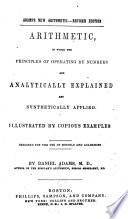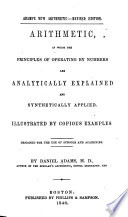 | Almon Ticknor - Arithmetic - 1846 - 276 pages
...or more numbers. RULE. 1. If there be two numbers • only, divide the greater by the less, and this divisor by the remainder, and so on, always dividing the last divisor by the remainder, till nothing remains, then. will the last divisor be the greatest common measure required.... | |
 | Daniel Adams - Arithmetic - 1848 - 330 pages
...of all the prime factors common to the several numbers will be the greatest common divisor. Or, II. Divide the greater number by the less, and that divisor...will be the greatest common divisor required. NOTE 1 — When we would find the greatest common divisor ol more than two numbers, we may first find the... | |
 | Daniel Adams - Arithmetic - 1848 - 342 pages
...of all the prime factors common ti5 the several numbers will be the greatest common divisor. Or, II. Divide the greater number by the less, and that divisor...will be the greatest common divisor required. NOTE 1. — When we would find the greatest common divisor of more than two numbers, we may first find the... | |
 | Daniel Adams - Arithmetic - 1848 - 330 pages
...or more numbers ? Repeat the rule for finding it. To find the greatest common measure of two RULE. Divide the greater number by the less, and that divisor...will be the greatest common divisor required. NOTE 1. — When we would find the greatest common divisor ol more than two numbers, we may first find the... | |
 | Daniel Adams - Arithmetic - 1848 - 320 pages
...is the greatest common divisor. Hence, To find tlie greatest common measure of tu-o numbers, RULE. Divide the greater number by the less, and that divisor...the last remainder, till nothing remain. The last dtmsor will be the greatest common divisor required. NOTE 1. — When we would find the greatest common... | |
 | Daniel Adams - Arithmetic - 1848 - 354 pages
...the less, and that divisor by the remainder, and so on, always dividing the last divisor by the lust remainder, till nothing remain. . The last divisor...will be the greatest common divisor required. NOTE 1. — When we would find the greatest common divisor ol more than two numbers, we may first find the... | |
 | Nathan Daboll, David Austin Daboll - Arithmetic - 1849 - 260 pages
...find the greatest common divisor of two numbers RULE. Divide the greater number by the less; and this divisor "by the remainder, and so on, always dividing the last divi•sor by the last r.vn?.inder till nothing remain ; and the last divisor will be the common divisor. EXAMPLES. t We Divide... | |
 | Roswell Chamberlain Smith - Arithmetic - 1850 - 314 pages
...apply to any number of successive divisions ; therefore, we have the following, — GENERAL RULE. 16. Divide the greater number by the less, and that divisor...the last divisor by the last remainder, till nothing remains ; the last divisor is the greatest common divisor required. 17. When the last divisor is 1,... | |
 | John Radford Young - Arithmetic - 1852 - 230 pages
...divisor a new dividend ; then make the second remainder a divisor, and the preceding divisor a dividend, and so on, always dividing the last divisor by the last remainder till the remainder disappears, or becomes 0. The divisor •which thus leaves no remainder is the G. c.... | |
 | J. R. Young - 1854 - 228 pages
...divisor a new dividend ; then make the second remainder a divisor, and the preceding divisor a dividend, and so on, always dividing the last divisor by the last remainder till the remainder disappears, or becomes 0. The divisor which thus leaves no remainder is the G. c. M.... | |
| |